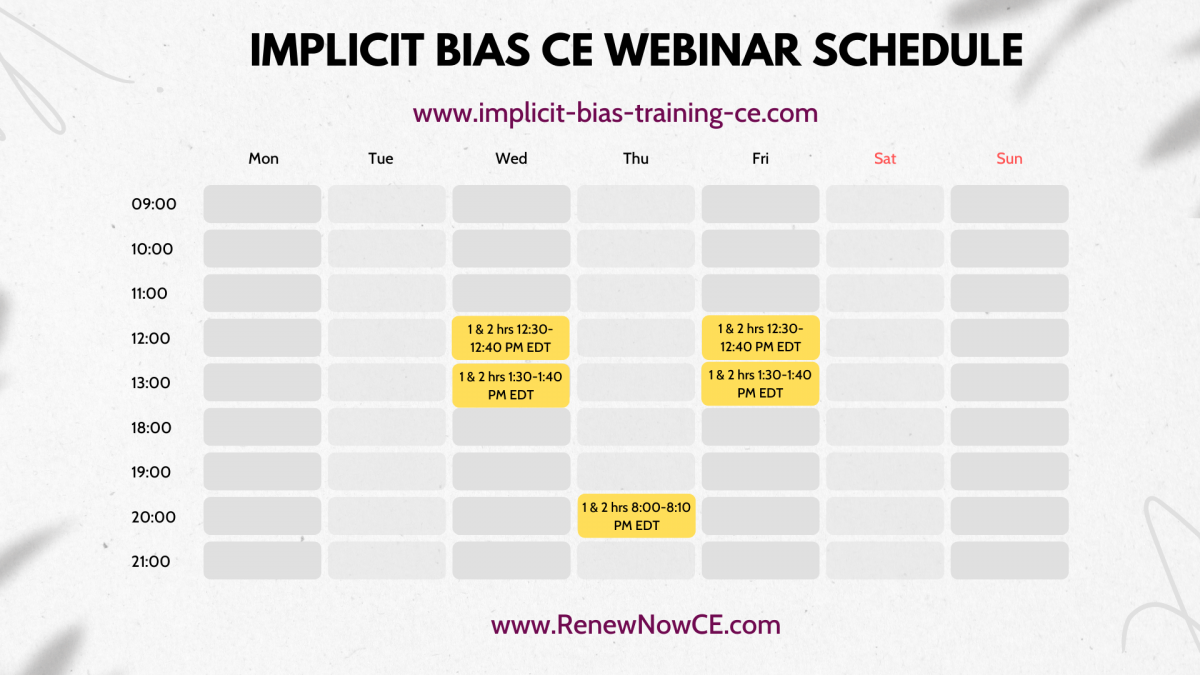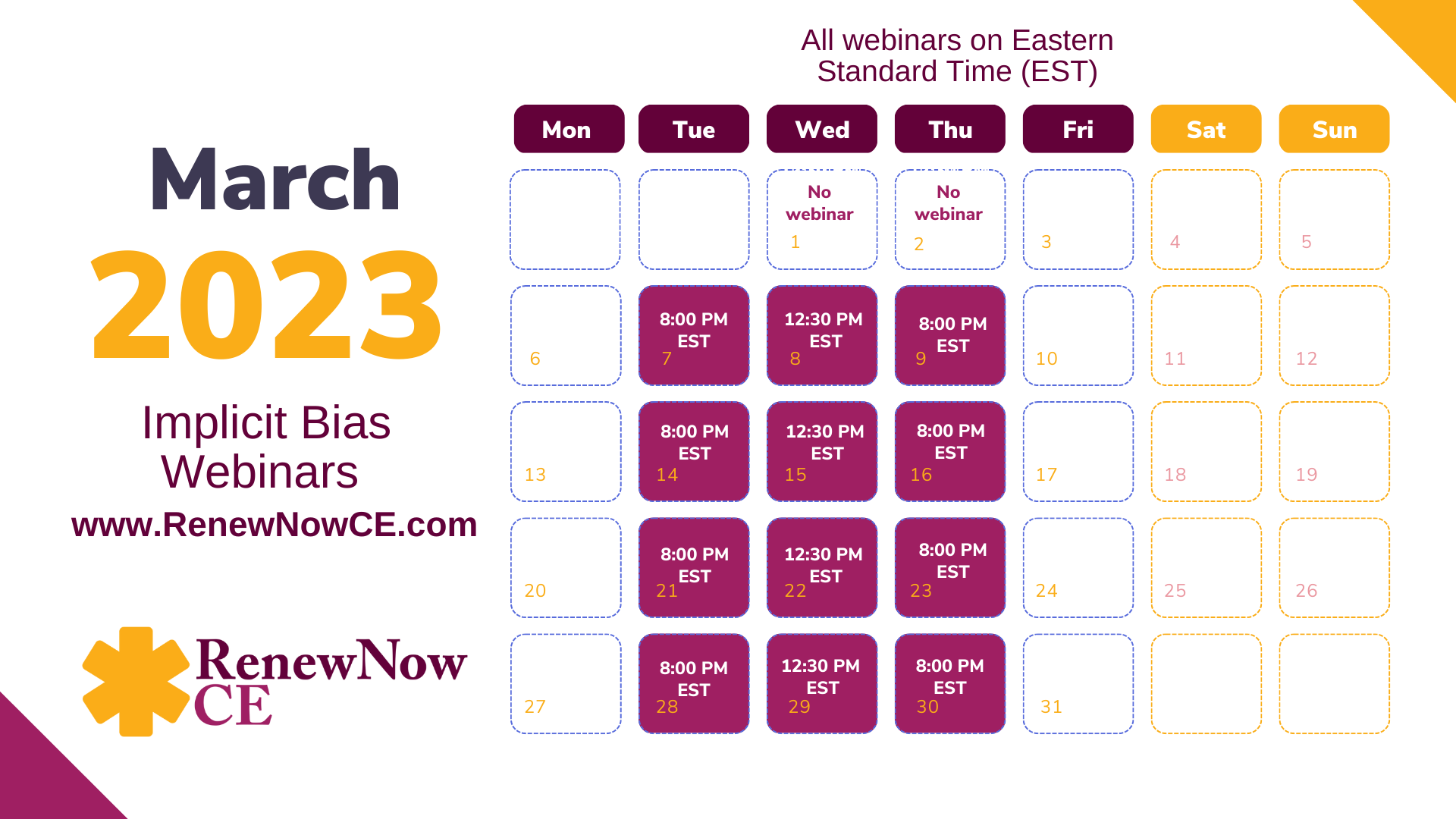One Hour Implicit Bias Ceu Course
One Hour Implicit Bias Ceu Course - Describe two methods used to assess and mitigate implicit bias. 1.0 ches category i cech*. Web implicit bias training for healthcare professionals—ceu, cme, ccm, cde | quality interactions buy for individual ce credit healthcare professionals can earn ceu, cme, ccm, cde credits with an implicit bias training course from quality interactions. Web ce and certificate available for $3. The region v public health training center is a designated provider (id# 99038) of continuing education contact hours (cech) in health education by the national. Learn more customers also bought this course: Course created on november 5, 2020. According to the california board of nursing, beginning january 1, 2023 a licensee within the first 2 years of holding their license, must complete 1 hour of direct participation in an implicit bias course offered by an approved continuing education. Recognize five different types of implicit bias. Web subsequent renewals will require 1 hour of implicit bias training for each year of the license or registration cycle. Web implicit biases are deeply ingrained attitudes and stereotypes that affect our judgments and behaviors, often unconsciously. 1.0 ches category i cech*. Web ce and certificate available for $3. Recognize five different types of implicit bias. Learn more customers also bought this course: The goal of this course is to provide healthcare employees with training about implicit bias in healthcare. In this course, you will learn about implicit bias and how it affects health equity in the healthcare field. This is a training requirement. Use code “hc15″ to receive 15% off the retail price. Recognize five different types of implicit bias. 1.0 contact hours of continuing education credit in implicit bias awareness training will be awarded after viewing the video recording and successfully completing (80%) the assessment. Web netce designates this continuing education activity for 3 continuing education hours for addiction professionals. Web this course satisfies the requirement for 1 hour of implicit bias for california nurses. Web implicit biases are. Web objectives after completing this course, the learner will be able to: 1.0 contact hours of continuing education credit in implicit bias awareness training will be awarded after viewing the video recording and successfully completing (80%) the assessment. This is a 1 ce credit hour qualified for all health care professionals in illinois. This continuing education (ceu) course aims to. Course content, registration, assessment, and records provided and maintained by the illinois. There are some differences in healthcare outcomes based purely on biological differences between people of different genders or races, but more evidence points to the vast majority of healthcare gaps. The agency for healthcare research and quality (ahrq) making healthcare safer (mhs) reports consolidate information for healthcare providers,. Learn more customers also bought this course: Professional issues sociocultural, diversity, and lifestyle choices. This continuing education (ceu) course aims to equip nurses and other healthcare. According to the california board of nursing, beginning january 1, 2023 a licensee within the first 2 years of holding their license, must complete 1 hour of direct participation in an implicit bias course. Web ce and certificate available for $3. *we report credits to nchec on a quarterly basis: Web netce designates this continuing education activity for 3 continuing education hours for addiction professionals. Web implicit bias training for healthcare professionals—ceu, cme, ccm, cde | quality interactions buy for individual ce credit healthcare professionals can earn ceu, cme, ccm, cde credits with an. Web $ 15.00 add to cart description this course fulfills mandatory implicit bias training requirements for healthcare professionals in most states including california, kentucky, illinois, indiana, minnesota, michigan, nebraska, new york, oklahoma, ohio, south carolina, tennessee, vermont, and washington. This is a training requirement. Web $15.00 get started for individuals for groups get access to these and all of our. Discover strategies that will help you reduce its influence to better meet the needs of those you serve. Web $ 15.00 add to cart description this course fulfills mandatory implicit bias training requirements for healthcare professionals in most states including california, kentucky, illinois, indiana, minnesota, michigan, nebraska, new york, oklahoma, ohio, south carolina, tennessee, vermont, and washington. Course objective the. In this course, you will learn about implicit bias and how it affects health equity in the healthcare field. As well as why it is important for providers to recognize and remove any biases that. This is a 1 ce credit hour qualified for all health care professionals in illinois. Web free nursing ceus / bias training. There are some. In this course, you will learn about implicit bias and how it affects health equity in the healthcare field. Web implicit bias training for healthcare professionals—ceu, cme, ccm, cde | quality interactions buy for individual ce credit healthcare professionals can earn ceu, cme, ccm, cde credits with an implicit bias training course from quality interactions. This continuing education (ceu) course aims to equip nurses and other healthcare. Course content, registration, assessment, and records provided and maintained by the illinois. What kind of training will satisfy the new implicit bias training rule? This is a training requirement. January, april, july, and october. Explain the rationale for why implicit bias presents challenges in health care. Course created on november 5, 2020. Web netce designates this continuing education activity for 3 continuing education hours for addiction professionals. 1.0 contact hours of continuing education credit in implicit bias awareness training will be awarded after viewing the video recording and successfully completing (80%) the assessment. Web this course will present the impact of implicit biases and other forms of discrimination on the provision of healthcare, as well as best practices to reduce implicit bias and the means to become a dei ally. The region v public health training center is a designated provider (id# 99038) of continuing education contact hours (cech) in health education by the national. As of december 2023, this. Web $ 15.00 add to cart description this course fulfills mandatory implicit bias training requirements for healthcare professionals in most states including california, kentucky, illinois, indiana, minnesota, michigan, nebraska, new york, oklahoma, ohio, south carolina, tennessee, vermont, and washington. The agency for healthcare research and quality (ahrq) making healthcare safer (mhs) reports consolidate information for healthcare providers, health system administrators, researchers, and government agencies about practices that can improve patient safety across the healthcare system—from hospitals to primary care.
New Implicit Bias Training Class Extended to 2 Hours

IMPLICIT BIAS COURSE 1 Contact Hour for Registered Nurses Licensed in

LARA Compliant Michigan Implicit Bias Training—CEU, CME, CCM, CDE

LARA Compliant Michigan Implicit Bias Training—CEU, CME, CCM, CDE

Implicit Bias 101 Office of Diversity, Equity, and Inclusion

Implicit Bias Continuing Ed Course Trailer YouTube

Implicit Bias Training CE Live Webinars

Implicit Bias Recognizing and Responding in Healthcare Settings (1 CE

Implicit Bias Training for Healthcare Professionals—CEU, CME, CCM, CDE

Implicit Bias Training CE Live Webinars
The Goal Of This Course Is To Provide Healthcare Employees With Training About Implicit Bias In Healthcare.
As Well As Why It Is Important For Providers To Recognize And Remove Any Biases That.
Professional Issues Sociocultural, Diversity, And Lifestyle Choices.
Web Free Nursing Ceus / Bias Training.
Related Post: